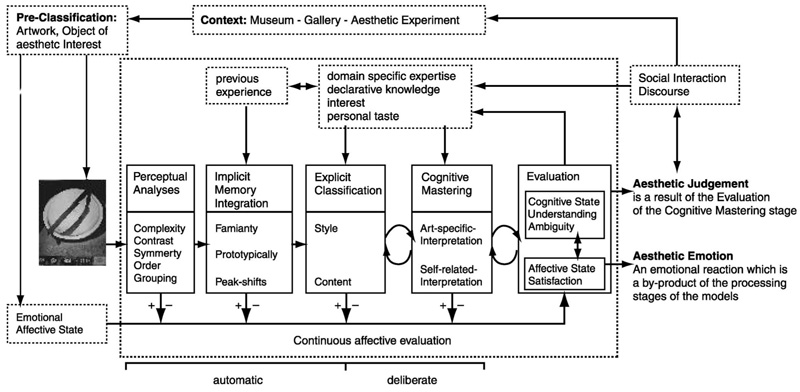Project abstract
Aesthetics as well as art history, psychology and neuroaesthetics assume that the perception of art induces a specific aesthetic experience (AE). The precise characteristic of this AE remains however a contended topic in scientific discourses. It is especially unclear what the characteristics of AE are and whether AE is measurable. Our project evolves from the hypothesis that time is a fundamental and characteristic difference between aesthetic vs. non-aesthetic experience in regard to the beholding of visual artworks. Whereas we normally dedicate a longer time span to regard works of art and derive aesthetic pleasure from it, common non aesthetic perception of an object leads to saturation, habituation and boredom. The project's aim is twofold: 1.) the verification of our hypothesis and 2.) to define the nature of AE more clearly, based on the empirically determined time courses (time is easily measurable and will provide a reference).

The model of aesthetic experience by Leder, Belke, Oeberst, and Augustin (2004) constitutes our theoretical framework. While cognitive surveys about art perception have mainly been studied in respect to early stages of the process – in the range of milliseconds up to a few seconds – we examine time courses of second to minutes. Based on the studies of Rosenberg (2011) who recorded and analyzed eye movements while paintings were observed for a 15 minutes time span, we measure how long people are willing to look at paintings and record corresponding physiological correlates (cognitive processes via eye-movements, emotional responses via facialEMG, heart rate, and electro-dermal activity). On the other hand we identify subjective and higher-order cognitive responses by verbal descriptions, evaluative dimensions, retrospective reports, and check-lists assessments. The analysis of those data and particularly the matching of physiological and subjective measures will uncover the characteristics of AE. In our studies, we will focus on three main variables, which we assume to have a strong influence on the time course of AE: 1) the subject’s previous experience and expertise, 2) the object’s (artworks) complexity, and 3) the context (viewing conditions in the laboratory vs. the museum).
This project combines approaches from psychology and art history in an innovative way to get a new theory of AE. A theory that would be out of reach without this interdisciplinary effort and that can serve as a new fundament for both disciplines. The cooperation is rooted in the newly established Cognitive Sciences Platform at the University of Vienna. Leder and Rosenberg, both co-founders of the platform, are internationally renowned researchers in their respective fields whose special interests converge in the empirical research of art.
Faculty of Psychology
University of Vienna
Liebiggasse 5
1010 Wien




